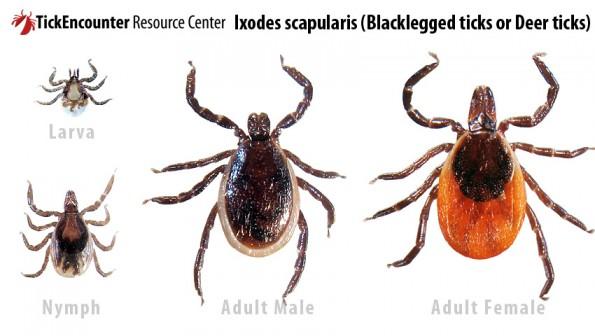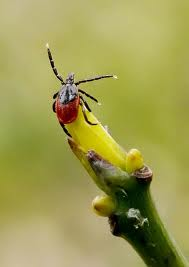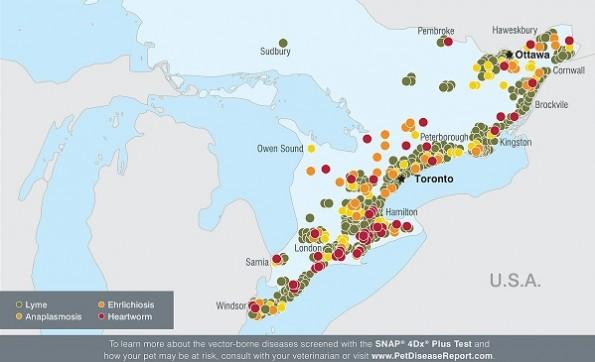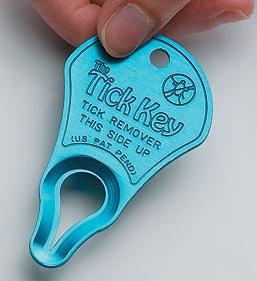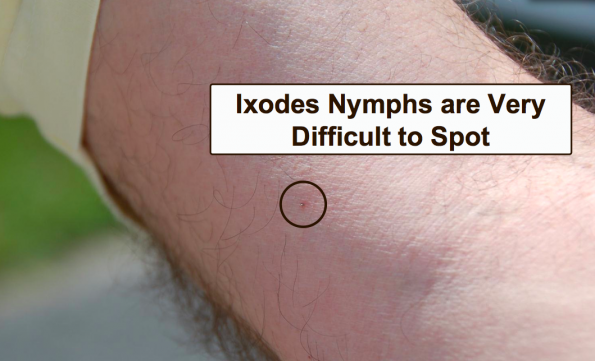Unfortunately ticks are becoming more prevalent in Ontario, and with them, the risk of contracting Lyme Disease.
Ticks are skin parasites that feed on the blood of their hosts. They are attracted to motion, warm temperatures from body heat, and the carbon dioxide exhaled by mammals.
The bite itself is not usually painful, but the parasite remains attached for 5-7 days and can transmit diseases such as Lyme Disease and cause tick paralysis, which is why tick control is so important.
Tick Life Cycle
Ticks have four life stages: egg, larva, nymph, and adult. Each stage requires a blood meal before it can molt into the next stage.
When eggs hatch, the larva attach to a mouse or bird for their first blood meal then detach and molt. Nymphs then repeat the cycle, detaching and becoming adults. Once mice become infected with lyme, they serve as a reservoir for the disease, infecting new larvae or nymphs. Adult ticks attach to mammals or birds for up to 12 days then detach and lay up to 3000 eggs each.
Ticks do not jump onto their victims, but climb up on long grass or bushes and sit with arms extended waiting to grab on to a passing mammal, bird or human. This is called ‘questing’.
Both adult ticks and nymphs can overwinter and are out looking for a blood meal first thing in the spring. This results in two danger periods for ticks in Ontario. The first runs from April to the end of June. This period consists of adults or nymphs that have overwintered searching for blood meals. By the end of June most adults looking for blood meals have found one and dropped off to lay their eggs.
July and August therefore have fewer ticks on the prowl until the eggs hatch, giving rise to the second danger period lasting from August until November.
Where do I find ticks?
Ticks do not jump but climb up on long grass or bushes and sit with arms extended waiting to grab on to a passing mammal, bird or human.
For this reason, ticks are found in forests or in long grass bordering bushy areas.
Unfortunately both ticks and lyme disease are spreading in Ontario.
The map below shows the prevalence of Lyme Disease
in Ontario in 2013 as detected by one veterinary lab.
Ticks can crawl on birds and hence travel long distances.
What to do if I find a tick on my pet?
The safest way to remove a tick is to use rubbing alcohol and a pair of tweezers. Dab rubbing alcohol on the tick, and then use the tweezers to take hold of the tick as close to the dog’s skin as you can; pull slowly and steadily. Try not to leave the tick’s head embedded in the dog’s skin. Don’t squeeze the tick because it might inject some disease-causing organisms, such as bacteria, viruses, protozoa, or other agents, into your pet during the process.
There are special tick removing instruments you can purchase which are easier to use, or, you can bring your pet to your veterinarian to safely remove the tick.
Next, save the tick and bring it to your local veterinarian. He or she can send the tick to the lab to identify and test it to see if it carries lyme disease. Ticks require 48 hours on your pet to transmit the disease so the sooner the tick is detected and removed the better. Your veterinarian will then be able to advise you whether treatment is required. Having the tick tested to see if it carries lyme disease is a good idea because your dog goes where you do and if ticks in your area carry lyme disease it is good to know about it for your family’s safety.
What should I look for in my pet if I suspect Lyme disease?
Clinical signs in dogs include not eating, lethargy, pain in the musculoskeletal system and joints [especially the carpus (wrist)], lameness, joint swelling, fever, enlarged lymph nodes, heart infection, complete heart block, glomerulonephritis (kidney infection), aggression, and seizures. Most cases are seen in May-August when the nymphs are feeding or in September-November when the adults are feeding.
What are the symptoms if I am infected?
In humans many case of lyme disease are transmitted by nymphs which are very small and hard to detect.
The initial primary symptom is a red rash. This progresses to flu-like symptoms and eventually inflammation of the nervous system, heart and joints.
Some people may develop post-Lyme disease syndrome (PLDS). A condition also known as chronic Lyme disease includes PLDS, but also other syndromes. Usually, these are characterized by persistent musculoskeletal and peripheral nerve pain, fatigue, and memory impairment.
For more information on Lyme Disease in humans go to the ‘Hopkins Medicine‘ website
What can I do?
In dogs we are fortunate that we have two products that help deal with ticks and prevent lyme disease.
First, we can products that address ticks. We have a topical, Advantix which is a topical that kills ticks and prevents them from grabbing hold of hairs to climb on your pet. This means that your dog will not be bringing any ticks or nymphs into the car or home. It also means that ticks won’t be able to bit and transfer lyme disease to your dog. This year we also have a pill that last 9 weeks and kills ticks that attach themselves to your dog.
The second tool we have is a vaccine for lyme disease that helps prevent your dog from developing the disease. This is important because dogs have long hair and it is often hard to detect a tick which means that they can feed and detach without you ever being aware your dog had a tick and the possibility of picking up lyme disease.
Another helpful trick is to wipe down both yourself and your dog with a lint roller when you exit the forest before getting into your car. The lint roller will pick up any ticks crawling on your clothing or your dog’s coat looking to attach themselves.
Our forests are wonderful this time of year and can be enjoyed safely if you take the proper precautions. Don’t stay away from them out of fear, but don’t ignore the ever-increasing threat of ticks. Protect your family and your pet.
Watch Dr. Brian Laing discussing Lyme Disease on Daytime

